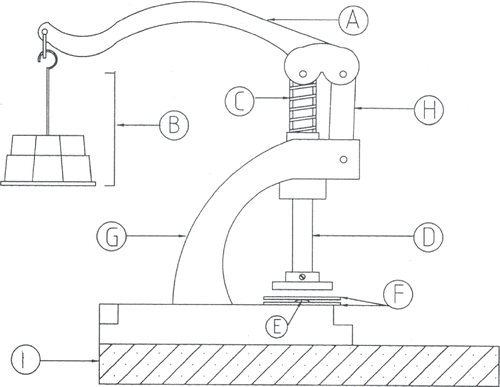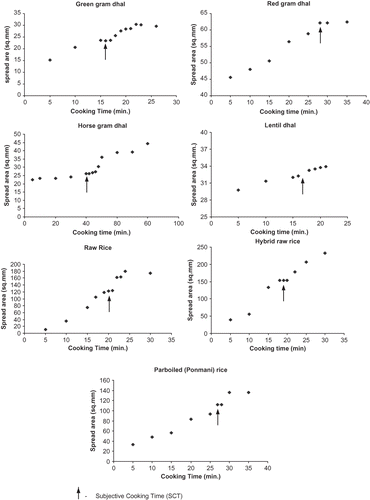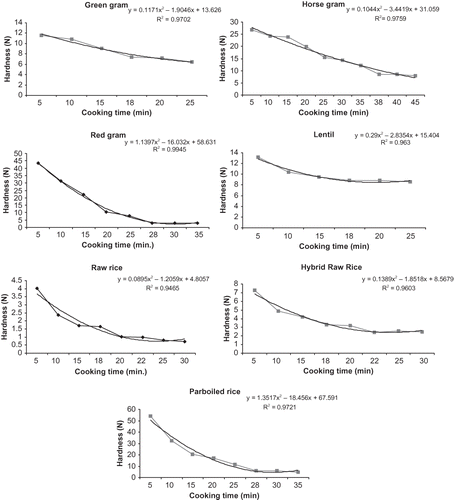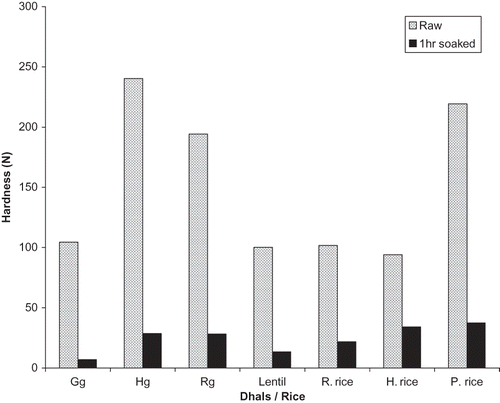Abstract
An objective method was developed to measure end point of cooking of dhals (green gram, horse gram, red gram, lentil) and rice (raw, parboiled) using a pressing device based on spread area ratio (SAR). Rice had higher SAR (7.5–15.4 mm2) than dhals (2.1–5.3 mm2). A steady value or change in slope of the curve (period of cooking vs. SAR) indicated the cooking time (CT) which corresponded to 20, 42, 17.8, 31 min (dhals) and 18.6, 18.5, 27.5 min (rice), respectively. This method corroborated well (r = −0.798 to −0.992 (dhals) and −0.632 to −0.698 (rice)) with data generated by Universal Testing Machine (UTM).
INTRODUCTION
Legumes, which are generally referred to as pulses in India, are important sources of plant food protein, calories and other nutrients. Grains like rice and dhals (dehulled split pulse) are widely consumed as soft cooked products and therefore cooking time is an important quality criterion for pulses. The cooking time varies from 1 to 3 h,[Citation1] the longest being for beans (Phaseolus vulgaris)[Citation2] particularly in the whole grain form. Varietal differences in cooking quality are known to exist even in the same pulse.[Citation3–5] Cookability depends upon various factors like variety, physical and chemical constituents. A large variability was observed in the cooking quality of pulses as well as their dhals.[Citation6] This was true among different pulses and also among different varieties of the same pulse. It has always been a difficult task to precisely assess the end point of cooking of pulses/dhals. Generally, cooking quality is considered to be a function of cooking time, which is the time of boiling the dhal in excess water until it attained desired soft texture and is ready for consumption.[Citation7] It has been shown as a function of water uptake, volume increase after cooking followed by dispersibility of solids into water and textural softening during cooking. Some of these could be used as indices of cooking.[Citation8] However, these do not provide a direct measure of texture of cooked pulse/dhal, which ultimately is the deciding factor for eating quality of pulse/dhal.
Several methods have been used for quantifying the texture of cooked grains and relating the same to their cooking times. Mattson[Citation4] described a device, named ‘Bean cooker’, for measuring cookability of yellow cowpeas. This device consisted of one hundred plunger-based rods wherein one rod was placed on each of the bean sample being cooked and the entire device was kept in a boiling water bath. Number of beans penetrated with progressive cooking was counted and the time, at which 50% of the grains were penetrated, was taken as cooking time (CT) of the sample. Chhinnan[Citation9] modified this unit for evaluating the degree of hardness in cooked beans, by introducing an electronic measuring device. Yusuf and Tabey[Citation10] surveyed different methods for measuring cooking quality of faba beans (Vicia faba). They included subjective methods, use of tenderometer, penetrometer and correlated the values measured to cookability.
The texture of cooked peas is generally assessed by a tasting panel but can be measured by a variety of instruments such as tenderometer,[Citation11] maturometer,[Citation12] shear press,[Citation13] and the hardness meter,[Citation14] which measure the force required to pierce, compress, or shear the peas. Voisey and Larmond[Citation15] have made a comparison of several methods for measuring texture of baked beans. They concluded that objective results (measured using the Kramer shear-compression cell, pea tenderometer) highly correlated with each other as well as with sensory ratings for hardness and cohesiveness of baked beans. Binder and Rockland[Citation16] used the shear press to study cooking rates of dry beans. However, most of these were applicable only for whole grains, based on compression or penetration of cooked grains and correlating the force required to fracture in terms of 50% compression of cooked grains.
Textural softening and end point of cooking is conventionally judged by pressing the cooked rice[Citation17] and dhal[Citation18] between two glass slides and taken as the time at which the opaque core in the kernel disappears. This method is rather subjective, varies from analyst to analyst, and also, it cannot be easily quantified. The nearest instrumental method, for the above objective measurement of degree of cooking is the uniaxial compression using Instron, which is commonly used for food texture investigations. Bera et al.[Citation19] have applied INSTRON tester to study the effect of soaking on degree of cooking of faba bean dhal.
Pillaiyar and Mohandoss[Citation20] have described an impact-pressing device and suggested that it could be used to differentiate the hardness of the texture of cooked rice, parboiled in different ways. Here a mild steel shaft was momentarily dropped from a pre-determined height (10 or 15 cm) on to a glass plate where the cooked rice is kept and the resulting pressed area is measured using a planimeter. The pressed area was determined for differently prepared parboiled rice samples and correlated to their sensory characteristics. They showed a positive relationship between the pressed areas of cooked rice to length/breadth ratio of the corresponding raw grains and suggested that this method could be used to distinguish differently processed parboiled rice samples.
In process quality control laboratories as well as research and development units, there is requirement for rapid and easy instrumental measurement of quality attributes to bypass, wherever possible, the more expensive and time consuming sensory analysis.[Citation21] However, the instrumental method should correlate well with the sensory analysis of the quality attribute. The present study was undertaken to develop a device that could be used for routine evaluation of judging the end point of cooking of dhals or rice in an objective manner. Present method evaluates degree of cooking by using compression method, quantifying the area to which the cooked grain spreads under the specified applied loads. Measurement of spread area as an index of cooking is rather new concept, which is closer to the existing texture measurement methods and has not been used earlier.
MATERIALS AND METHODS
Commercial samples of four types of dehusked split pulses (dhals), namely green gram (Phaseolus aureus), horse gram (Dolichos biflorus), red gram (Cajanus cajan), lentil (Lens esculantus), which provided wide variation in cookability and three kinds of rice (commercial raw rice, hybrid raw rice, and ‘Ponmani’-parboiled) were purchased locally. They were cleaned and size graded manually by removing small and split grains, chaff, etc., and uniform sized grains were used for the study. The grains were stored in airtight containers at 4°C in order to minimize quality changes and to avoid infestation and drawn as and when required. Before using the grains for experiments, they were equilibrated at room temperature for 48 h.
Cooking Time Determination
Cooking time was evaluated as per Narasimha et al.[Citation18] 10g dhal or rice was added to 100 ml boiling (98°C) distilled water and the time was noted. The water level was maintained constant. After about 10 min, few grains were drawn and pressed gently between two glass plates to test the softness. This was repeated at selected intervals. The time required for the grains to soften without any hard centers or white core were assessed. Three replicates of each sample were thus assessed for their cooking times. The times at which the grains attained subjective cooking time (SCT) were determined.
Sample Preparation
After assessing their SCTs, different time intervals were fixed to draw samples for determining cookability by using the new objective method developed in the present study. At the end of the cooking period, the grains were removed from water and the surface moisture was removed by blotting gently between two hand-made filter sheets. The samples were kept in petridishes lined with a wet filter paper (to avoid drying of grains) for conditioning for 30 min.
Cooked Dhal Pressing Device (CDPD)
The device (as shown in ) comprises of a ram (plunger, piston) D moving linearly in the housing G. The lever A was hinged through the fulcrum link H connected at one end to the said housing, the other free end of the said lever A carrying a loading platform B or the site to provide of known weights on the loading platform B. Addition of known weights on the platform B depresses the lever A which in turn pushes the ram D downwards against the restoring force of the spring C placed between the lever A and the housing G concentric with the ram D. The downward movement of ram D thus, presses the cooked sample E kept between two glass plates F of suitable thickness or any other suitable plates of any other suitable material of construction. The entire assembly of the above said component is mounted on a wooden or any other convenient base I for purposes of stability and ease of operation.
Determination of Spread Area using CDPD
Dhals or rice, cooked for different periods of time were placed between two glass plates (F) and was kept under the ram (D). They were kept pressed under the predetermined weights for 30 seconds and pressing operation was stopped by removing weights (B) from the hook or releasing the load. The ‘spread area’ (SA) of the cooked dhal or rice was determined by counting number of squares on a centimeter graph sheet by photo-projection method and measurements were carried out during cooking at regular intervals from 5 minutes onwards till the grain was fully cooked as determined subjectively. However, the SA was measured every minute near the subjectively determined cooking time (SCT) of the grain. A graph was plotted with spread area (mm2) against time (min) for the entire range of cooking period.
Optimization of Weights for Pressing Different Dhals and Rice
Twenty grains each drawn at various intervals were pressed gradually in CDPD, for 30 seconds using selected weights kept on the pan, ranging from 300, 500 and 700 g. Slides were then removed and the spread area (SA) of individual grains was marked on the glass slides with a marker. The spread area (mm2) values of the grain area were noted.
Instrumental Texture Measurement
Samples of dhal or rice cooked for different periods of time (0 min to their cooking time in min) were subjected to mean peak force measurement by uniaxial compression method, in UTM (Instron – model 4301,Instron Corporation, Massachusetts) after 30 min conditioning. The texture analyzer (UTM) consisted of a stationary bottom plate and upper movable crosshead. The movable crosshead was connected to a load cell of 1000 Newton, to record force exerted to achieve 50% compression of cooked grain's height, with a crosshead speed of 50 mm/min with a probe diameter of 35 mm. All testing was done with the UTM installed inside a room maintained at 25°C. During the operation, the orientation of grains was kept uniform, by placing its flat sides facing downwards. The peak compression force (N) was determined as the mean value of 10 replicates from the same batch.
The relative hardness (HR) of samples was calculated as the ratio of the mean force at different intervals of cooking to that of raw dhal. This was done to reduce the effect of absolute values, by conversion into dimensionless numbers. The Spread Area Ratio (SAR) at different cooking times was correlated with HR. The initial value of the cooking time (raw grains) was taken as 0% cooking and at the end point of cooking as 100% cooking. The end point of cooking coincided with the attainment of steady values of peak compression force. Cooked samples of rice were analyzed similarly using Instron.
Spread Area Ratio (SAR) of Cooked Dhal/Rice
The SAR of cooked dhal/rice at different cooking times was calculated as follows.
Statistical Analysis
The data generated during the study was analyzed statistically using randomized block design with three replicates and by calculating significance through modified ‘t’ test.[Citation22]
RESULTS AND DISCUSSION
The subjective cooking times (SCT), corresponding spread area (SA), spread area ratio (SAR) and their UTM hardness values are given in . The cooking time varied between 18 to 40 min for dhals and 20 to 27 minutes for raw and parboiled rice respectively. Relative increase in SAR at the respective cooking times () was maximum in case of horse gram (5.3) among dhals followed by green gram (3.6). The lentil had SAR of 2.16 while red gram dhal had 2.6, indicating the differences in rate of softening behavior of cooked dhals. The raw rice, hybrid raw rice, and ‘Ponmani’ parboiled rice showed high SARs of 15.4, 11.9, and 7.5, respectively, indicating its high textural softness, perhaps due to its higher starch content and tendency to expand more during cooking.
Table 1 Subjective cooking time, UTM values, spread area and spread area ratio of the Dhals/Rice
The UTM values obtained at the different cooking times (), as judged by tactile method, of dhals/rice were in the range of 1.1 to 8.8 N. The nearest instrumental method for the objective measurement of degree of cooking was the uniaxial compression testing. Kostaropoulos[Citation23] established that the compression test fits better to the related sensory analysis.
The actual areas of the raw grains, spread area of the cooked samples (middle and end of cooking), as formed on the glass slides while pressing are shown in . It can be seen that there was a gradual increase in spread area as cooking time increased. The spread areas of the grains during progressive cooking are plotted against the respective times of cooking are presented in . It can be seen that, at 500 g load, as the cooking progressed, the SA increased from 6.9 to 27.6 till 19 min and 11.33 to 26.1 till 40 min for green gram dhal and horse gram dhal respectively, after which it became relatively constant. Similarly, the SA increased from 23.86 to 62.1 mm2 till 28 minutes in case of red gram dhal, while lentil dhal showed an increase from 15.54 to 33.71 sq.mm. Among rice samples, raw and hybrid raw, showed an increased SA from 9.68 to 123.9 and 12.79 to 153.8 (from raw to CT) while the parboiled rice had relatively lower SA (14.79 to 111.6 mm2), probably due to partially gelatinized and retrograded starch during the processing. As the initial values for the areas were different for different dhals /rice, spread area ratio (SAR) was used to compare their cooking quality using CDPD.
Figure 2 The slides showing ‘Area of Raw,’ ‘Spread Area’ of middle CT, and end CT of Dhals / Rice. 1: raw; 2: middle of cooking; and 3: end of cooking.
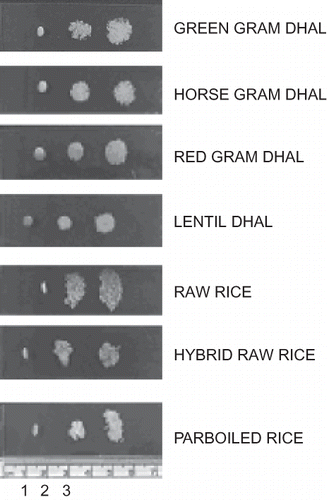
Though the trend was similar at both loads of 500 or 700 g, the latter tended to cause more damage to the cooked texture by disintegrating the structure. Similar observation was made by Chakraborty et al.[Citation24] who noticed the difficulty to measure the expansion ratio of cooked pigeon pea dhal if pressed using heavy weights. This resulted in greater variability among samples. The 300 g load was found not enough to cause sufficient expansion on pressing and compute the steadiness in SA. Hence, 500 g load was fixed for all samples. Ramesh et al[Citation25] determined the degree of cooking of green peas, carrot, radish etc using Instron, indicating the relationship between the mechanical properties of vegetables, mean compression force and cooking time.
The cooking times determined by the tactile method (SCT) and by CDPD (computing spread area) for different grains are presented in . This was compared with the instrumental method-UTM system. The force (N) required for 50% compression of cooked grain's height of sample at CT is expressed as relative hardness (HR), which was found to be in good agreement (r = − 0.744) with that determined using the CDPD. The HR was calculated using the formula HR = NCT/No, where No and NCT are the force required for raw and cooked samples. It can also be seen that the differences in CT's as determined by SCT, UTM and CDPD do not have significant variation (p < 0.05) indicating the compatibility of the present method with that of UTM of various dhals and rice samples.
Table 2 Comparison of various methods tested for determining cooking times of different grains
shows the relative hardness (HR) and SAR values of 1 h soaked dhal/rice as well as their cooked samples at progressive cooking ranging from 5 min. to their respective CT's. It can be seen from the table that the HR decreased from 1 during progressive cooking till CT and remained same afterwards indicating full cooking of dhal/rice at this time and leading to a steady soft cooked texture.
Table 3 Relative Hardness (HR) and Spread Area Ratio (SAR) of Dhals/Rice during progressive cooking
The SAR gradually increased from 1 to 4.1 and attained a steady value depending on the dhal. In rice samples the increase was from 1 to 18 depending on the type of rice. The correlation coefficient for HR and SAR was highly significant for dhals (r = −0.798 to −0.992) and moderately significant for rice (r = −0.632 to −0.698). The decrease in hardness of samples of dhals and rice during progressive cooking, which was measured by UTM, is given in . It can be seen that the gradual decrease in hardness of cooked samples differed from dhal to dhal and from dhal to rice. In red gram dhal and green gram dhal, the hardness decreased substantially within 15 min while in case of horse gram dhal, it decreased gradually from 26.7 to 15.4N in 25 minutes, indicating the differential cooking behavior of various dhals. Taherian et al.[Citation26] in their studies on textural softening of heat-treated beet root have observed that texture values of heat-treated products were evaluated by a computer-interfaced compression-testing machine using a single-cycle deformation test. The force-to-deformation ratio was taken as a measure of sample firmness. Ereifej,[Citation27] in his study on Seed characteristics of wild legume (Tetragonolobus palaestinus), as compared with Lens culinaris and Pisum sativum has also observed significant variation among the seeds of the three species with respect to their cookablility and physical characteristics.
In case of rice, the hardness of parboiled rice decreased from 55 to 17N in 20 min, while the raw one showed a decrease from 4 to 1N in the same time interval. The results apparently indicated rapid decrease in hardness in first phase of cooking in case of harder samples (red gram dhal, parboiled rice) than relatively softer samples (green gram dhal, lentil dhal and raw rice). The above data of cooking times and corresponding degree of softening were fitted into second order polynomial equation (R2 > 0.95).
shows the hardness values of raw and one hour soaked samples. The decrease in hardness of samples ranged from 63.6–93.3%, the least being for hybrid raw rice. The maximum softening effect upon soaking was observed in red gram dhal. The result indicated the basic differences in the hydration capacity of different dhals and rice at room temperature (27°C).
CONCLUSIONS
The developed device was simple to operate and can be used as an indicator to assess the degree of cooking by measurement of end point of cooking of commercial varieties of dhals (green gram, horse gram, red gram, lentil) and rice (raw and parboiled). The subjective cooking times of the dhals were ∼18, 40, 28, and 18 min while that of rice were 18–20 min for the raw grains. The respective UTM values were 19, 42.5, 19, and 29 N while the values from CDPD were 20, 42, 17.8, and 31N, which are very close. The gradual pressing of the cooked grains using specified force, removes subjectivity in judging the end of cooking and enables a direct measurement of the texture of cooked grains, in terms of spread area: SA. Pre-determined SA for a specific dhal can be used for calibration against another standard instrumental method such as UTM. It can be adopted for assessing the cookability of grains (varieties of rice, dhals from different pulses and other grains) for routine laboratory evaluation and could be included as a quality check parameter.
REFERENCES
- Muneta , P. 1964 . The cooking time of dry beans after extended storage . Food Technology , 18 ( 8 ) : 1240 – 1241 .
- Morris , H.J. and Wood , E.R. 1956 . Influence of moisture content on keeping quality of dry beans . Food Technology Champaign , 10 : 225 – 229 .
- Kon , S. , Brown , A.H. , Channeson , J.G. and Booth , A.N. 1973 . Split peeled beans—preparation and some properties . Journal of Food Science , 38 ( 3 ) : 496 – 498 .
- Mattson , S. 1948 . The cookability of yellow peas. A colloid—chemical and biochemical study . Acta.Agri.Scand II , 2 : 185 – 231 .
- Shankaran , S. and Srinivasan , V. 1963 . Evaluation of red gram types for cooking quality . Madras Agricultural Journal , 50 : 470 – 472 .
- Singh , U. 1999 . Cooking quality of pulses . Journal of Food Science Technology , 36 ( 1 ) : 1 – 14 .
- Singh , U. , Sehgal , S. and Tomer , Y.S. 2000 . Influence of dehulling, soaking solution and enzyme treatment on cooking quality of improved varieties of pulses . Journal of Food Science and Technology , 32 : 122 – 125 .
- Subba rao , P.V. , Ananthachar , T.K. and Desikachar , H.S.R. 1964 . Effect of certain chemicals and pressure on cookability of pulses . Indian Journal of Technology , 2 ( 12 ) : 417 – 418 .
- Chhinnan , M.S. 1985 . Development of a device for quantifying hard-to-cook phenomenon in cereal legumes . Trans. Am. Soc. Agri. Eng. , 28 : 335 – 339 .
- Yousef , M.M. and El-Tabey , A.M. 1981 . Cooking Quality of faba beans (Vicia faba) . Newsletter, Faba-Bean-Information-Service , 3 : 16 – 17 .
- Martin , W.M. 1937 . The tenderometer—an apparatus for evaluating tenderness in peas . Canning Trade , 59 : 7 – 14 .
- Lynch , L.J and Mitchell , R.S. Physical measurement of quality in canning peas . Coun. Scien. Inv. Res. Org. 1950. Bull. No. 254 (Australia). ,
- Kramer , A. , Burkhardt , G.J. and Rogers , H.P. 1951 . The shear press, a device for measuring food quality . Canner , 112 ( 5 ) : 34 – 36 .
- Doesburg , J.J. and Grevers , G. 1952 . Metingen van de hard-heid van verse en ge conserverde tuinbouwproducten . Conserva , 1 ( 5 ) : 150 – 157 .
- Voisey , P.W. and Larmond , E. 1971 . Texture of baked beans—a comparison of several methods of measurement . Journal of Texture Studies , 2 : 96 – 109 .
- Binder , L.B. and Rockland , L.J. 1964 . Use of the automatic recording shear press in cooking studies of large dry Lima beans (Phaseolus lunatus) . Food Technology , 18 : 1071 – 1074 .
- Ranghino , F. 1966 . Evaluation of the resistance of cooking as a function of the time of gelatinization of the grains . Riso , 15 : 117 – 127 .
- Narasimha , H.V. and Desikachar , H.S.R. 1978 . Objective methods for studying cookability of tur pulse (Cajanus cajan) and factors affecting varietal differences in cooking . Journal of Food Science and Technology , 14 ( 2 ) : 47 – 50 .
- Bera , M.B. , Salu , K.L. , Mukherjee , B. , Barale , M. and Sherman , Y.K. 1990 . Temperature dependence of the softening and cooking rate of faba bean dhal . Journal of Food Science and Technology , 27 : 15 – 18 .
- Pillaiyar , P. and Mohandoss , R. 1981 . A pressing device to measure the texture of cooked rice . Journal of Texture Studies , 12 : 473 – 481 .
- Sawyer , F.M. 1971 . International of sensory panel and instrumental measurement . Food Technology , 25 ( 3 ) : 51 – 52 .
- Rangaswamy , R. 1995 . A text book of agricultural statistics , New Delhi : New Age International Publications Ltd .
- Kostaropoulos , A.E. 1981 . The introduction of an empirical expression in the texture studies of vegetables . Food Science and Technology , 14 : 97 – 99 .
- Chakraborty , S.K. 2001 . Process parameters optimization for instant pigeon pea dhal , Pantnagar : M.Tech. Thesis, G.B.Pant University of Agriculture & Technology .
- Ramesh , M.N. , Sathyanarayana , K. and Girish , A.B. 1997 . Determination of degree of cooking of vegetables by compression testing . Journal of Food Science and Technology , 34 ( 3 ) : 218 – 221 .
- Taherian , A.R. and Ramaswamy , H.S. 2009 . Kinetic Considerations of Texture Softening in Heat Treated Root Vegetables . International Journal of Food Properties , 12 ( 1 ) : 114 – 128 .
- Ereifej , K.I. 2004 . Seed characteristics of wild legume (Tetragonolobus palaestinus) as compared with Lens culinaris and Pisum sativum . International Journal of Food Properties , 7 ( 3 ) : 639 – 646 .
